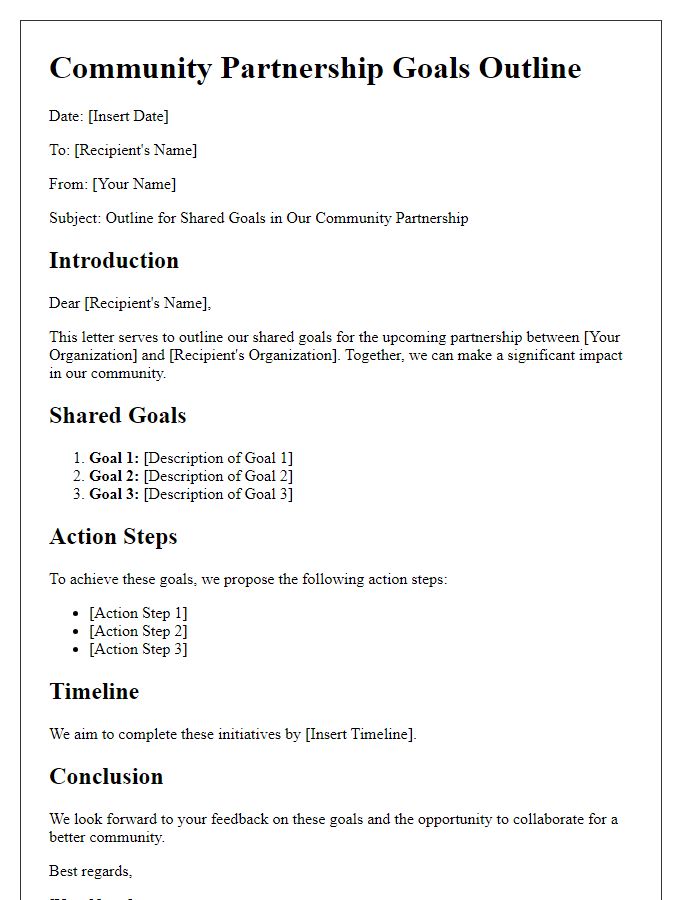Building strong community partnerships is essential for fostering collaboration and driving positive change. By joining forces with local organizations and stakeholders, we can create impactful initiatives that benefit everyone involved. This letter aims to outline the potential for collaboration and the exciting opportunities that lie ahead. So, let's dive in and explore how we can work together to make a difference in our community!

Clear Objective Statement
Community partnership development requires a clear objective statement that articulates the purpose of collaboration. This objective should outline the specific goals intended to be achieved, such as enhancing local educational resources, promoting sustainable practices within the community, or fostering economic growth through local businesses. Key stakeholders may include nonprofit organizations, local government agencies, and business leaders who contribute to the initiative. Identifying metrics for success, such as increased participation rates in community programs or improved access to services, can provide a measurable framework. Additionally, delineating roles and responsibilities among partners strengthens the shared vision for community transformation, ensuring all parties are aligned toward achieving common objectives.
Mutual Benefits Highlight
Community partnerships often yield significant mutual benefits, enhancing local initiatives and promoting sustained engagement for all parties involved. Collaborations between non-profit organizations and local businesses can generate economic growth through joint events, such as community fairs and fundraisers, which foster stronger relationships among residents in cities like Atlanta, Georgia, known for its vibrant community spirit. Schools collaborating with local governments can implement educational programs designed to teach students about sustainability, improving environmental awareness while benefiting local parks and recreational areas. Furthermore, the exchange of resources, such as volunteering hours or expertise from local professionals, strengthens community bonds, creating networks of support that can address pressing issues like homelessness and food insecurity. This synergistic approach not only amplifies the reach and impact of initiatives but also enhances the overall quality of life in the community, making it a win-win situation for everyone involved.
Specific Partnership Opportunities
Community partnership development often focuses on specific opportunities that enhance collaboration and benefit local stakeholders. Strategic alliances can encompass initiatives like educational programs between local schools and businesses, enabling students to gain practical experience while fulfilling workforce needs. Health outreach efforts may involve nonprofits partnering with local healthcare providers to address issues such as diabetes awareness in underserved communities. Environmental projects could see collaborations between municipalities and green organizations, aiming to improve urban parks or implement recycling initiatives. These partnerships not only leverage resources but also encourage community engagement, fostering a sense of shared responsibility among residents and organizations.
Contact Information and Call to Action
A community partnership development initiative focuses on collaboration among local organizations, businesses, and residents. Effective communication tools serve as vital components in fostering these partnerships. Providing clear contact information, including names, email addresses, and phone numbers of key personnel, facilitates easy outreach and encourages engagement. A compelling call to action, such as inviting stakeholders to a community meeting on November 15, 2023, at the local community center in Springfield, emphasizes the importance of participation and the collective impact of collaborative efforts. This type of outreach nurtures a strong, interconnected community, enhancing social cohesion and resource sharing.
Professional Tone and Formatting
Establishing a community partnership requires a thorough understanding of mutual goals and interests. Collaborative projects can drive social improvement, enhance local resources, and foster connections among diverse groups. For example, local non-profits, educational institutions, and businesses might unite for community enrichment initiatives, such as literacy programs or environmental clean-up efforts. Clear communication and shared objectives are vital, with digital platforms like collaborative project management tools supporting coordination among partners. Regular meetings, such as quarterly evaluations, ensure accountability and progress tracking, which can encourage engagement from all stakeholders involved in the partnership.
Letter Template For Community Partnership Development Samples
Letter template of invitation for potential community partnership collaboration.

Letter template of acknowledgment for existing community partnership support.

Letter template of feedback request for community partnership initiatives.

Letter template of impact report for community partnership achievements.

Letter template of renewal for ongoing community partnership agreements.

Letter template of introduction for new community partnership opportunities.








Comments